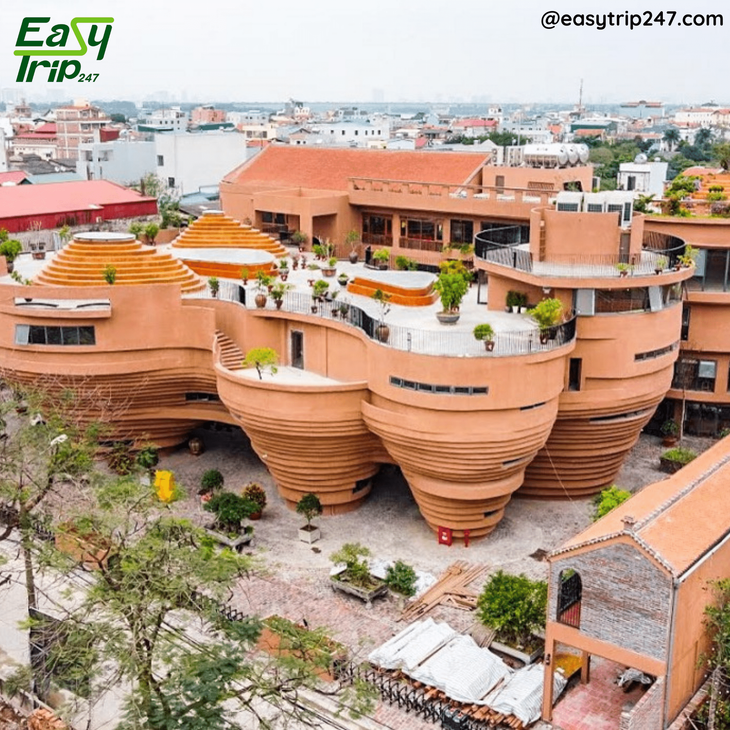Best Time to Visit Vietnam: Ultimate Guide for Every Traveler – Exploring Bat Trang Pottery Village
On
23/06/2025Reading time:
1 min
Summary:
Located just a short drive from Hanoi, Bat Trang is a centuries-old ceramics village nestled on the banks of the Red River. It’s not just a destination; it’s a living museum of Vietnamese craftsmanship, tradition, and community. If you’re drawn to authentic experiences, stunning artistry, and historical richness, this enchanting village deserves a top spot on your itinerary

The best time to visit Vietnam, particularly Northern Vietnam where Bat Trang is located, is during the spring (March to April) and autumn (October to early December). These seasons offer a temperate climate—cool breezes, blue skies, and comfortable humidity—that allows you to wander through the narrow alleys of the village and soak in the earthy scent of clay and tradition. During these months, the pottery workshops are in full swing, local artisans are more active, and the light filtering through the old brick kilns and mossy walls adds a dreamlike quality to your visit. It’s the ideal setting for photographers, culture lovers, and curious explorers alike.
Understanding the best time to visit Vietnam also means understanding its regional climate. While the south stays warm year-round and the central coast has its own seasonal quirks, Northern Vietnam, including Hanoi and Bat Trang, undergoes clear seasonal changes. Visiting during the winter (December to February) might expose you to chilly, gray days, while summer (May to August) brings intense heat and sudden rain showers. These can make outdoor activities, such as pottery making or walking tours through Bat Trang’s markets, less enjoyable. Hence, spring and fall truly offer the perfect climate for immersive travel.
What makes Bat Trang so special isn’t just the pottery—it’s the people, the stories, and the way time seems to slow down as you walk through its maze of kilns and art studios. And this is precisely why choosing the best time to visit Vietnam is important. During the ideal seasons, locals are more inclined to welcome travelers into their workshops, offer pottery classes, or share tea while telling tales of their ancestors’ crafts. These intimate moments form the core of what makes Bat Trang unforgettable.
Another reason why spring and autumn are considered the best time to visit Vietnam is the number of festivals and cultural events that happen around this period. Bat Trang itself hosts traditional festivals that reflect the village’s spiritual and artistic soul. Visiting during Tet (Vietnamese Lunar New Year, usually late January to mid-February) can be thrilling, but also overwhelming due to crowd levels and closures. However, a few weeks before or after Tet, the village glows with decorative pots, handmade gifts, and a festive spirit without the heavy footfall. It’s a culturally rich window that seasoned travelers often aim for.
For families traveling with kids or couples looking for a romantic yet educational escape, the best time to visit Vietnam will align with school holidays or quieter tourist seasons. Bat Trang is a great destination for hands-on experiences: imagine spinning your own ceramic vase on a potter’s wheel, painting your own designs, or simply shopping for unique, handcrafted pieces that carry the soul of Vietnam. When the weather is pleasant, these activities become even more enjoyable, offering comfort and inspiration in equal measure.
Let’s not forget food—a major highlight of any Vietnamese trip. In Bat Trang, you can try local specialties like bánh tẻ (rice cakes wrapped in dong leaves), bún chả (grilled pork with rice noodles), and che (a sweet dessert soup) sold by friendly vendors. The best time to visit Vietnam allows you to enjoy these culinary delights in outdoor settings, surrounded by peaceful village life and the occasional ring of a bicycle bell echoing through the alleyways.
Another compelling reason to time your visit wisely is the light. Photographers and content creators know that Vietnam’s natural light can drastically change throughout the year. The golden hues of autumn or the clear, vibrant colors of spring make Bat Trang’s ceramic glazes pop like never before. When planning your trip, remember that the best time to visit Vietnam aligns with when this picturesque village looks its finest—perfect for capturing those timeless travel memories.
What’s also worth noting is that the best time to visit Vietnam coincides with fewer tourist crowds in Bat Trang compared to larger cities like Hanoi or Ho Chi Minh City. While spring and fall are popular, the village still retains a peaceful, off-the-beaten-path charm. You’ll find yourself leisurely exploring, chatting with artisans, and truly appreciating the slow, creative rhythm of the village—without the chaos that usually accompanies high tourist seasons elsewhere.
Travelers who are culturally inclined often ask whether they can witness the pottery-making process or even try it themselves. The answer is a resounding yes—but only if you pick the best time to visit Vietnam. During the hot summer months, many workshops reduce hours due to the sweltering heat. Conversely, the colder months can see a slowdown in tourist-focused activities. But in spring and fall, the pottery wheels spin non-stop, workshops are buzzing with energy, and artisans are more than happy to teach their craft.
If sustainability and ethical travel are part of your travel values, Bat Trang offers an excellent opportunity. Supporting local artisans by buying directly from their family-run studios ensures that your money goes where it matters. Choosing the best time to visit Vietnam also supports these businesses during their peak production seasons, helping maintain traditional crafts in a rapidly modernizing world.
In conclusion, if you're wondering about the best time to visit Vietnam, especially for a culturally immersive and meaningful experience like Bat Trang Pottery Village, the answer lies in the shoulder seasons of spring and autumn. These months offer a harmonious balance of weather, accessibility, and authenticity. Whether you’re shaping your own clay bowl, exploring centuries-old kilns, or simply enjoying a cup of tea with a ceramic artist, the village rewards you with memories that linger long after you’ve left.
So, as you chart out your travel plans, remember that the best time to visit Vietnam is not just about temperature or rainfall—it’s about timing your journey to match the heartbeat of its most beautiful destinations. And Bat Trang, with its blend of heritage, art, and humanity, is waiting to be discovered by travelers who know that the soul of a place is often found in its smallest corners.
Design Your Tour Today And Get A Quote. Contact Us Here: +84.975.504.825
Source: Easytrip247 Team compiled.
